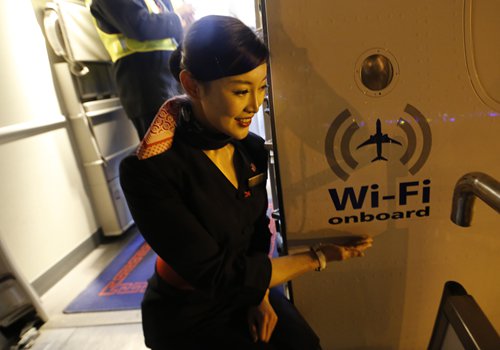In-flight Internet about to take off
Shareco CEO touts potential of on-board services, despite challenges

An air stewardess stands by a Wi-Fi logo on a Chinese Eastern Airlines flight in January in Qingdao, East China's Shandong Province. Photo: CFP

Brooks Pan Photo: Courtesy of Beijing Shareco Technologies
Most people live with an uninterrupted connection to the Internet, so losing that link during a flight - even for just a few hours - can be disappointing.
Until recently, an airplane cabin was one of the last few unconnected islands on this connected world.
Over the last few years, more and more airlines have been offering passengers in-flight Wi-Fi on at least some flights, but connectivity remains far from a standard feature in China.
That being said, more and more players are beginning to tap the market. In November, Beijing Shareco Technologies Co and Global Eagle Entertainment Inc (GEE) announced that Shareco plans to acquire up to a 34.9 percent stake in GEE for approximately $416 million. The deal would make Shareco GEE's single largest shareholder.
Shareco, a subsidiary of HNA Group, is a technology company focusing on providing in-flight entertainment and connectivity services.
GEE is the third largest in-flight connectivity solutions provider, the largest in-flight entertainment content distributor and supplier, and the largest maritime satellite communications operator in the world.
"Now is the right time for the in-flight connectivity business to take off," Brooks Pan, CEO of Beijing Shareco Technologies, told the Global Times in an exclusive interview on Friday.
Popular demand
More and more major Chinese airlines, including China Eastern Airlines, China Southern Airlines and Air China, have received approval to test in-flight Wi-Fi.
In May 2015, more than 40 aircraft from five airlines including China Eastern and Air China were allowed to carry out Ku-band satellite-based Internet access service.
China Eastern now operates about 300 flights a week that have in-flight Wi-Fi. By the end of 2016, it is expected to have more than 50 airplanes equipped with the service.
However, compared with overseas airlines that have been offering in-flight Wi-Fi for years, Chinese carriers are still in the testing stage.
Airlines from developed economies have been adding in-flight Wi-Fi since the technology became available in 2005, helping to grow its popularity. In 2007, the US launched a ground-based base station air access system. Since then, the world's major airlines have been equipping their planes with in-flight Wi-Fi capabilities.
"About 70 percent of the global fleet provides in-flight services, compared with 2 percent of that in China," Pan said. "But our market potential is huge."
A July survey by Honeywell found that with the rise in personal electronic devices, consumers expect reliable connectivity anywhere, including while in flight. Of those surveyed, 60 percent said they would most likely feel disappointed or frustrated if they got on a plane that did not have in-flight Wi-Fi.
Even more respondents - 84 percent - said it is important to have an experience identical to what they have at home or in the office. Most travelers - 90 percent - said it is now essential to have a reliable connection throughout their entire flight anywhere in the world. And that connection ought to be fast enough to stream video from sites such as YouTube and Netflix, according to 83 percent of those surveyed.
In July, Finnair said that it would begin installing Wi-Fi on its long-haul Airbus A330 aircraft in October and aimed to finish by May 2017.
Regulations and technology
Pan said there are two obstacles to getting Wi-Fi on more planes in China. "One is the in-flight ban on smartphones, and the other is the limited bandwidth technology of satellites," he said.
Although it has been reported that regulators are planning to lift the smartphone ban, they are proceeding cautiously, Pan said.
"I suppose they could reopen the policy discussion as early as late 2017," he said.
There's not much the industry can do about the satellite bandwidth problem, other than wait for new satellites to replace the old ones, Pan noted.
Pan said that several satellites will have to be retired in two or three years, which will offer his company some opportunities.
The new satellites will provide a lot more bandwidth for in-flight Internet connections, though the bandwidth on Chinese flights will still lag behind that of US flights, Pan noted.
Currently, passengers are still not allowed to use their mobile phones on flights in China, which means they can only use tablet and laptop computers to get online, and only when the plane is above 3,000 meters. Regulations still prohibit the use of all electronic devices during takeoff and landing.
To charge or not to charge
In Pan's eyes, there is a big gap between China and the US in terms of technology, products, policies and services, but he is still optimistic about in-flight services in China, especially in regard to the business model.
Most airlines from other countries and regions prefer to charge for their services online, but Chinese carriers like to offer free in-flight services and charge for value-added services, which can be an important channel for them to increase their profits, Pan said.
According to a statement Finnair sent to the Global Times, the Finish airline's economy class passengers can purchase Internet access at an hourly rate of 5 euros ($5.23) an hour or spend 15 euros to have the connection for the entire flight.
Pan said Shareco plans to rebuild 800 airplanes in five years so they can connect with in-flight services.
In-flight services are different from those on land because the ceiling is the passengers in the cabin, but the products and services have no limitations, and so airlines can earn money with the value-added services such as advertisements, games or e-commerce, Pan said.

